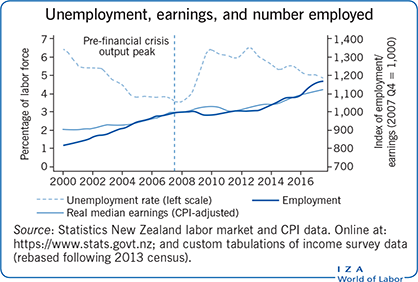Elevator pitch
New Zealand is a small open economy, with large international labor flows and skilled immigrants. Since 2000, employment growth has kept pace with strong migration-related population growth. While overall employment rates have remained relatively stable, they have increased substantially for older workers. In contrast, younger workers as well as the Maori and Pasifika ethnic groups experienced a sharp decline in employment rates and a rise in unemployment around the time of the global financial crisis. Wage gains have been modest and there has been a compression of earnings differentials by gender as well as by skill.

Key findings
Pros
Total employment has grown substantially, though a concurrently increasing population means that the employment rate has remained relatively steady.
Employment rates for older workers have risen substantially.
The gender wage gap has declined.
The proportion of employed workers with tertiary qualifications has increased substantially.
Lower job turnover rates indicate greater stability for employed workers.
Cons
Unemployment is still above its pre-crisis level, and long-term (six months or more) unemployment remains high at 33%.
Young workers as well as Maori and Pasifika ethnic groups continue to face higher than average unemployment rates.
Wage inequality has risen somewhat in the upper half of the wage distribution.
The tertiary earnings premium has declined, and high-level tertiary qualifications (Master’s and above) are under-represented.
Reduced job turnover indicates less labor market liquidity, reducing the scope for reallocation.